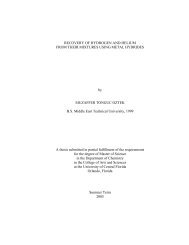Create successful ePaper yourself
Turn your PDF publications into a flip-book with our unique Google optimized e-Paper software.
hydrides by dissolving large amounts of hydrogen. All phases of metal-hydrogen systems<br />
other than random interstitial solid solutions are designated as hydrides [12]. Depending<br />
on the nature of the metal-hydrogen bond, hydrides are classified into three types:<br />
covalent, ionic or metallic hydrides. Covalent and ionic hydrides have non-metallic<br />
character whereas metallic hydrides preserve the metallic properties of the original metal<br />
or alloy.<br />
The solution reaction predecessor to hydride formation is described by five partial<br />
steps:<br />
1. H 2 (g, bulk) H 2 (g, gas-solid interface)<br />
2. H 2 (g, interface) H 2 (physisorbed on metal M)<br />
3. H 2 (phys) 2 H (chemisorbed on M)<br />
4. H (chem.) H (dissolved in M, solid solution α-phase)<br />
5. diffusion of H in M<br />
In the case of adherent hydride layer formation at the metal-gas interface, additional<br />
reaction steps are involved [13];<br />
6. diffusion of H through the MH x layer<br />
7. M + x H (in MH x ) MH x (β-phase)<br />
When the concentration of hydrogen atoms in the α-phase (solid solution phase)<br />
exceeds the solubility limit at the given temperature, β-phase (hydride) is formed.<br />
Hydrogen dissolution and hydride formation are physical and chemical processes,<br />
respectively.<br />
5



